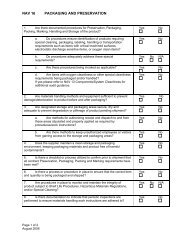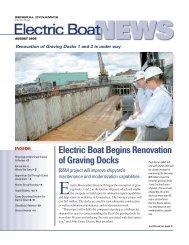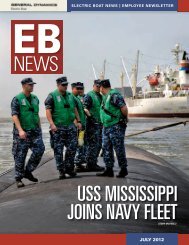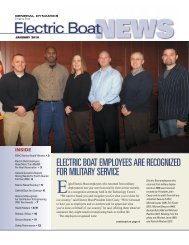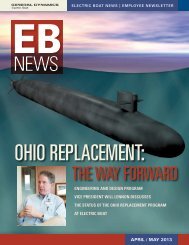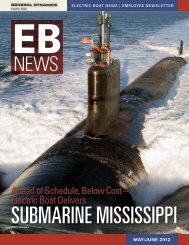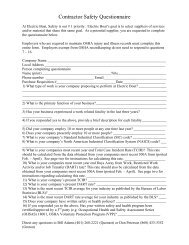EB March NL - Electric Boat Corporation
EB March NL - Electric Boat Corporation
EB March NL - Electric Boat Corporation
Create successful ePaper yourself
Turn your PDF publications into a flip-book with our unique Google optimized e-Paper software.
MARCH 2009<br />
INSIDE<br />
Submarine Suppliers Meet<br />
with Members of Congress • 2<br />
Earned Hours • 3<br />
Engineering and Design<br />
Orientation Program • 4<br />
Workshops Provide Trade Instructors<br />
Training • 4<br />
Former CO of SSGN Ohio Praises<br />
Ship’s Capabilities • 5<br />
Engineering and Design Mentors<br />
Honored for Contributions • 6<br />
Ethics • 7<br />
Health Matters • 8 / 9<br />
Daffodil Sales • 9<br />
Classified • 10<br />
Service Awards • 11<br />
Safety Performance • 12<br />
SUBMARINE SUPPLIERS MEET<br />
WITH MEMBERS OF CONGRESS<br />
USS Providence Arrives at Groton<br />
for Maintenance and Modernization<br />
The Los Angeles-class submarine USS Providence (SSN-719) arrives at the Groton shipyard in <strong>March</strong><br />
for routine maintenance and modernization work. Under the terms of a $34.9 million contract awarded by<br />
the U.S. Navy, <strong>Electric</strong> <strong>Boat</strong> will perform a Selected Restricted Availability, which consists of repairs,<br />
maintenance work, alterations and several major systems upgrades. The work will involve up to 300 employees<br />
at its peak and is expected to be completed by fall.
The two co-chairmen<br />
of the Submarine<br />
Industrial Base<br />
Council are, left,<br />
Dan DePompei,<br />
marketing and sales<br />
director for DRS<br />
Power Technology,<br />
Fitchburg, Mass.,<br />
and James Jelinek,<br />
president and CEO<br />
for Moog Flo-Tork,<br />
Orville, Ohio.<br />
Submarine Suppliers Meet<br />
With Members of Congress<br />
WASHINGTON<br />
<strong>Electric</strong> <strong>Boat</strong> representatives joined nearly 200 executives<br />
representing 85 companies from 25 states who met earlier<br />
this month with members of Congress about the<br />
submarine industry's importance to the nation's security during<br />
the Submarine Industrial Base Council (SIBC) 18th annual Supplier<br />
Days conference.<br />
SIBC co-chair Jim Jelinek said he was extremely encouraged<br />
by the increased numbers of members of Congress, congressional<br />
staffers and submarine suppliers at this year's event.<br />
"I felt the increased attendance and enthusiasm was especially<br />
helpful in continuing to spread our message across Capitol Hill<br />
that submarines are crucial to our nation's security and to ensuring<br />
our undersea dominance."<br />
On the first day, Capt. Michael Jabaley, the Navy's Virginiaclass<br />
program manager, briefed the SIBC members on the status<br />
of the Virginia-class submarine program. He highlighted a number<br />
of program accomplishments in 2008, including the commissioning<br />
of the USS New Hampshire (SSN-778), which was<br />
delivered eight months early and more than $60 million under<br />
target cost.<br />
He said the hard work of the suppliers and the submarine<br />
shipbuilders, <strong>Electric</strong> <strong>Boat</strong> and Northrop Grumman Shipbuilding,<br />
has reduced the cost of building the Virginia-class submarines,<br />
which led to the signing of a multi-year Block III contract<br />
in December 2008 for the next eight Virginia-class submarines.<br />
The suppliers received a brief on SSGN operations by Capt.<br />
Christopher Ratliff, former commanding officer of USS Ohio<br />
(SSGN-726). Ohio was the first of four former Trident ballisticmissile<br />
submarines (SSBNs) converted to conventional strike<br />
platforms that can carry up to 154 Tomahawk cruise missiles<br />
and more than 60 fully outfitted Special Forces. Rear Adm.<br />
Stephen Johnson, the Navy's director of Strategic Systems Programs,<br />
described for SIBC members the numerous achievements<br />
the SSBN force has accomplished over the past four decades,<br />
and pointed out its continued importance to national security.<br />
The second day started with a meeting in the Rayburn House<br />
Office Building attended by Senators Chris Dodd (D-Conn.),<br />
Jack Reed (D-R.I.) and Sheldon Whitehouse (D-R.I.), and Representatives<br />
Mike Coffman (R-6th Colo.), Joe Courtney (D-2nd<br />
continued on page 3<br />
2 I <strong>March</strong> 2009 I ELECTRIC BOAT NEWS
Dan Barrett,<br />
Editor<br />
Bob Gallo,<br />
Gary Slater,<br />
Gary Hall,<br />
Photography<br />
<strong>Electric</strong> <strong>Boat</strong> News is<br />
published monthly by the<br />
Public Affairs Department,<br />
75 Eastern Point Road,<br />
Groton, CT 06340<br />
Phone (860) 433-8202<br />
Fax (860) 433-8054<br />
Email dbarrett@gdeb.com<br />
Earned Hours: Where We Stand<br />
Each of the 14 members<br />
stressed the value of<br />
submarines to national<br />
security, especially on<br />
irregular warfare missions<br />
for which they are<br />
uniquely suited.<br />
Also attending were<br />
30 congressional staffers<br />
representing offices from<br />
16 states.<br />
Congressman Dicks<br />
assured the SIBC audience<br />
that Navy procurement<br />
programs would not face<br />
the chopping block when<br />
Congress starts debating<br />
the budget in April.<br />
continued from page 2<br />
Conn.), Roscoe Bartlett (R-6th Md.), Tim Bishop (D-1st N.Y.), Eric Massa (D-29th<br />
N.Y.), Charlie Dent (R-15th Pa.), James Langevin (D-2nd R.I.), Robert Wittman (R-1st<br />
Va.), Glenn Nye (D-2nd Va.), Randy Forbes (R-4th Va.) and Norm Dicks (D-6th<br />
Wash.).<br />
Each of the 14 members stressed the value of submarines to national security, especially<br />
on irregular warfare missions for which they are uniquely suited. Also attending<br />
were 30 congressional staffers representing offices from 16 states.<br />
Congressman Dicks assured the SIBC audience that Navy procurement programs<br />
would not face the chopping block when Congress starts debating the budget in April.<br />
"The Appropriations Committee recognizes the need for full funding of the Navy's<br />
shipbuilding plan, particularly in addressing the shortfall for fast attack submarines," he<br />
said.<br />
Rep. James Langevin, co-chairman of the Congressional Submarine Caucus, cautioned<br />
suppliers to not let up in their efforts, saying, "We can't take it for granted that<br />
other members of Congress are as passionate and knowledgeable as we are about submarines<br />
and the level of protection they provide to our national security."<br />
Following the meeting, SIBC members broke up into delegations for more than 100<br />
scheduled meetings with members of Congress and their staffs. SIBC members urged<br />
Congressional support for three issues: support for continued funding of the Virginiaclass<br />
submarine program, support for submarine research and development, and support<br />
for the funding expected to be requested by President Obama for the Ohio-class<br />
SSBN replacement program.<br />
ELECTRIC BOAT NEWS I <strong>March</strong> 2009 I 3
Workshops Provide Trade Instructors With Tools To Improve Training<br />
<strong>Electric</strong> <strong>Boat</strong>’s Training organization<br />
recently conducted a series<br />
of “train the trainer” sessions in<br />
an effort to increase the knowledge retention<br />
rates of employees participating in<br />
classroom training sessions.<br />
According to Chief of Operations<br />
Training Karen Armstrong, this goal will<br />
be achieved by transforming instructional<br />
strategies and techniques to more effectively<br />
suit adult learning styles.<br />
Some 52 trades instructors at the Groton<br />
shipyard and 30 trades instructors at<br />
the Quonset Point facility completed the<br />
three-day workshops. Twenty-two managers<br />
in Groton participated in a one-day<br />
overview of the workshop while an additional<br />
15 managers at Quonset Point are<br />
slated to do the same in the near future.<br />
During the managers’ workshop, attendees<br />
learned about various participantcentered<br />
learning techniques and identified<br />
how management could best support<br />
instructors with the implementation of<br />
this initiative.<br />
Steve Labrecque, Director of Safety/IH<br />
& Training, stated the course reflects the<br />
Training organization’s mission and commitment<br />
to develop and maintain a<br />
Participants at a “train the trainer” workshop held at Quonset Point demonstrate the concept of a technique<br />
called “window paning” in which information is “chunked” into manageable groups. From left<br />
are John McGinn (915), Mike Clark (915), Rick Legge (921), Matt Farley (915) and Fred Gadoury (915).<br />
skilled work force that meets contractual<br />
requirements and production goals by:<br />
Working with internal and external<br />
customers to identify gaps in skills and<br />
knowledge.<br />
Developing and delivering effective<br />
training to close these gaps.<br />
Measuring the effectiveness of training<br />
programs, and integrating the results<br />
into continuous process-improvement<br />
initiatives.<br />
Specifically, the workshop provided<br />
instructors additional skills to:<br />
continued on page 7<br />
Engineering And Design Mentors Honored For Contributions<br />
Eighty members of <strong>Electric</strong> <strong>Boat</strong>’s engineering and design<br />
organization were recognized recently for their efforts to<br />
mentor coworkers.<br />
The mentors were honored based on nominations submitted<br />
by the employees they are helping on the job. The event was part<br />
of a week-long program, “<strong>EB</strong> Technical Excellence,” celebrated<br />
during National Engineers’ Week.<br />
“I don’t think there’s anything more important at <strong>Electric</strong> <strong>Boat</strong><br />
than a mentor,” said Herb Rattley, director of <strong>Electric</strong>al Design<br />
and Engineering, who conducted the recognition event in the<br />
Technology Center. “No matter how long you’re here, you’ll<br />
always remember your mentor.<br />
“We chose to award our mentors because we understand they<br />
perform a critical function in the development of technical excellence<br />
at <strong>Electric</strong> <strong>Boat</strong>,” he said. “Your efforts to transfer your<br />
knowledge to others are invaluable to the company and the<br />
employees you’re helping,” he told the mentors. “Because of the<br />
time you take to teach your fellow employees, I believe we have the<br />
best group of technical people anywhere who can do anything.”<br />
MDA-UAW President Bob Canova noted that very often,<br />
engineers will mentor design apprentices, while senior designers<br />
will show the ropes to junior engineers. “Mentoring crosses over<br />
lines, and that’s important,” he said. “I want to thank each of you<br />
for having the patience to take the time, and the willingness to<br />
pass on your knowledge and personal experience. It’s because of<br />
people like you that <strong>Electric</strong> <strong>Boat</strong> is recognized for its technical<br />
excellence – there is nothing we cannot do.”<br />
During the event, Rattley read from a sampling of nomination<br />
forms:<br />
“I was a young and inexperienced test engineer who did not<br />
continued on page 10<br />
4 I <strong>March</strong> 2009 I ELECTRIC BOAT NEWS
Former CO Of SSGN Ohio Praises Ship’s Capabilities<br />
As part of the first team that took the first SSGN out<br />
on real-world missions, Capt. Chris Ratliff left no<br />
doubt about the ship’s performance when he<br />
recently addressed an audience of <strong>Electric</strong> <strong>Boat</strong> engineers.<br />
“Ohio SSGN does everything it was designed to do, and does<br />
it very well,” said Ratliff, who was the Blue Crew captain when<br />
Ohio deployed from October 2007-December 2008. The ship<br />
departed with a load of 105 missiles, not to mention Special<br />
Operating Forces gear that was available by the tractor trailer<br />
load, tons of ordnance to support their missions, and of course<br />
the exercise equipment so they stayed near their peak in terms of<br />
readiness.<br />
“Once we got into theater we were ready to go do any mission<br />
in the SOF repertoire, without any requirement to go restock,”<br />
Ratliff said. “We can stay on station and do mission after mission<br />
after mission, and the SEALs are just as prepared to do<br />
their work on day 30 as they were on day one.”<br />
The ship was ready to go as well. Though it spent 14 months<br />
and one week forward deployed, with just 63 days of maintenance<br />
and an operational availability of 67 percent, it returned<br />
to Bangor, Wash., in top material condition. In fact, at the 10-<br />
month point, Ohio hosted a Navy team for a major inspection<br />
while forward deployed, and performed up to the most rigorous<br />
standards, he said.<br />
“That’s pretty remarkable – I think we’re the only nation in the<br />
world to be able to deploy this kind of advanced technology for<br />
that long a period of time,” Ratliff said.<br />
Ratliff spoke in the Technology Center’s third-floor conference<br />
room as part of a series of National Engineers’ Week events<br />
coordinated by Senior Engineer Megan Roberts (210). Roberts<br />
assembled experts for 15 presentations on various topics. These<br />
included Director of Ship Test Dave McCall (272), who spoke<br />
about personal responsibility, and Senior Engineer Tim Ryan<br />
(210), who described the company’s technology exploration<br />
efforts, as well as outside presenters such as the commanding<br />
officers of USS North Carolina and USS Hawaii, who told<br />
audiences about their operational experiences with Virginia-class<br />
submarines.<br />
Ratliff noted that most major platforms are built to accommodate<br />
one or two types of ordnance, such as an attack plane<br />
that delivers specific types of bombs. “SSGN doesn’t have that<br />
kind of limitation because of the volume, because of the size of<br />
the interface to the sea,” Ratliff said. “Our book is wide open.<br />
We’re limited only by our imagination.”<br />
Others see the SSGN as a replacement for submarines such as<br />
USS Kamehameha and USS James K. Polk, which he characterized<br />
more as “SOF buses,” which brought SEALs into an area<br />
covertly, but were not designed to support them ashore as the<br />
Ohio SSGN is.<br />
During a question and answer period, Ratliff was asked if<br />
there were capabilities he would like to see incorporated into any<br />
new SSGNs, should the opportunity arise. He responded that for<br />
the moment the imagination of the submarine community is<br />
focused more on how to use the potential of the existing SSGNs,<br />
because they have barely begun to scratch that.<br />
For instance, he said, using dry-deck shelters (Ohio deployed<br />
with two of them) imposes some operational restrictions on the<br />
SSGN, but that issue might be resolved without any changes to<br />
the ship, if the SEAL delivery vehicles that go in them can be<br />
incorporated into the large-volume tubes that already exist on<br />
the ship.<br />
“Those are the kinds of things that we need to be looking at<br />
to make the ship even more effective,” Ratliff said. But even with<br />
operational restrictions, “There is no doubt in my mind that the<br />
SSGN can operate in a littoral environment.”<br />
USS Ohio (SSGN-726) visits Naval Station Pearl Harbor on the return leg of<br />
its historic first deployment as a guided-missile/special operations support<br />
submarine. Pearl Harbor was the final stop for Ohio before it returned to its<br />
home port of Bangor, Wash. The submarine departed Naval Base Kitsap<br />
Oct. 14, 2007 for its maiden deployment, which began a month ahead of<br />
schedule. (U.S. Navy photo)<br />
ELECTRIC BOAT NEWS I <strong>March</strong> 2009 I 5
Engineering<br />
And Design<br />
Continues<br />
With New Hire<br />
Orientation<br />
Program<br />
If you had to rank disorienting<br />
experiences, starting a new job<br />
would be at the top end of the list.<br />
With that realization, <strong>Electric</strong> <strong>Boat</strong>’s<br />
Engineering and Design organization has<br />
developed a program to familiarize new<br />
hires with the company and its customer.<br />
“Since the program was introduced<br />
two years ago, hundreds of new <strong>Electric</strong><br />
<strong>Boat</strong> employees have passed through the<br />
guiding hands of dedicated volunteers<br />
whose passion for their work has made<br />
the New Hire Orientation Program a<br />
huge success,” said Manager of Engineering<br />
Peter DiCarlo. He and Manager<br />
of Engineering Cathy Smith are cochairpersons<br />
of the program.<br />
The Orientation Program has evolved<br />
and improved throughout the years. The<br />
current program, under the direction of<br />
Peter Halvordson, VP – Engineering,<br />
kicked off in April 2007 to support the<br />
influx of new hires, which started in the<br />
fall of 2006. Assisting Halvordson have<br />
been Dept. 210 Executive Staff Rotation<br />
Program participants Courtney Murphy,<br />
Phil Brant and Megan Roberts.<br />
The Orientation Program provides<br />
new hires with a wealth of information<br />
crammed into two half-day sessions.<br />
Topics covered include:<br />
Submarines 101<br />
Navy Missions<br />
<strong>EB</strong> Projects & Programs<br />
Career Opportunities<br />
The Rotation Program<br />
Tuition Reimbursement<br />
The Model Room<br />
The Apprentice Program<br />
Participants in the Engineering and Design organization’s orientation program for new hires take part in the<br />
<strong>Electric</strong> <strong>Boat</strong> version of the game show Jeopardy.<br />
The highlights of the orientation are<br />
sessions by Dave McCall, the former CO<br />
of USS Seawolf who presents Submarine<br />
101 along with some entertaining sea stories;<br />
John B. Padgett III, a retired twostar<br />
admiral who provides an “inside the<br />
beltway” overview of ship authorization<br />
and procurement; and Tom Purcell,<br />
whose description of <strong>EB</strong> programs and<br />
potential work opportunities includes<br />
music and videos that get the heart<br />
pumping, said DiCarlo. A recent favorite<br />
among the new hires has been an <strong>Electric</strong><br />
<strong>Boat</strong> version of the TV game show Jeopardy<br />
in which class members are grouped<br />
by their directors and compete for bragging<br />
rights.<br />
Based on positive feedback and suggestions<br />
from the orientation classes, program<br />
organizers recently made all presentation<br />
material available at<br />
http://www.ebnet.gdeb.com/homepages/o<br />
rganizations/EngNewHire/ on the “New<br />
Hire Orientation” link on the <strong>EB</strong><br />
intranet. In addition, the McCall, Padgett<br />
and Purcell presentations are available<br />
on videotape.<br />
The program’s success is attributable to<br />
the efforts of many volunteers. They have<br />
included Harry Haugeto, Cathy White,<br />
Jim Costello, Jack Morgan, Tom<br />
Walther, Jack Chapman, Peter Schilke,<br />
Carl Lins-Morstadt, Priya Wing, Mark<br />
Panosky, Jen Panosky, Judy Pragluski,<br />
Chris Lane, Rachel Tucker, Terrie Pangilinan,<br />
Bo Miller, Jim Cassidy, and John<br />
Gullotti, and representatives from the<br />
MDA-UAW and the Rotation Program.<br />
6 I <strong>March</strong> 2009 I ELECTRIC BOAT NEWS
<strong>EB</strong> Business Ethics<br />
and Conduct<br />
New Mandatory Disclosure Rules Summary<br />
<strong>Electric</strong> <strong>Boat</strong> recently issued a new SP 01-33 addressing changes to the<br />
Federal Acquisition Regulations (FAR) implemented last December,<br />
which impose significant reporting obligations on <strong>Electric</strong> <strong>Boat</strong> and other<br />
defense contractors to disclose certain violations of criminal law, civil<br />
False Claims Act violations as well as significant contract overpayments in<br />
connection with the award, performance or closeout of U.S. government<br />
contracts.<br />
The new rules have two separate reporting requirements, one to avoid<br />
suspension or debarment under FAR Subpart 9.4 and the other as a specific<br />
contract clause requirement under FAR 52.203-13 that will be<br />
included in all new solicitations and contracts exceeding $5 million with a<br />
period of performance greater than 120 days.<br />
Under FAR 9.4, to avoid suspension or debarment, it is now mandatory<br />
that we report to the government whenever we have credible evidence<br />
of violation of federal criminal law that involves bribery, illegal gratuities,<br />
fraud or conflict of interest; violation of the civil False Claims Act; or significant<br />
contract overpayments.<br />
Although this new disclosure requirement was effective on December<br />
12, 2008, it applies to all contracts currently held, as well as all contracts<br />
on which final payment was received within the last three years. Due to<br />
the fact that this element of the new rule requires disclosure of certain<br />
prior violations, <strong>Electric</strong> <strong>Boat</strong> must ensure that prior violations not previously<br />
reported to the government are escalated to the <strong>Electric</strong> <strong>Boat</strong> legal<br />
department or ethics director to determine whether they must now be<br />
reported. To comply with the new FAR 52.203-13 contract clause, the<br />
same reporting obligations apply with respect to federal criminal violations<br />
and violations of the civil False Claims Act, except that in both<br />
instances these matters need to be reported to the agency IG office with a<br />
copy to the contracting officer.<br />
These new rules represent an important change in the relationship<br />
between defense contractors and the federal government. In the past contractors<br />
were encouraged to voluntarily disclose these types of violations<br />
to the government and it has been the practice of <strong>Electric</strong> <strong>Boat</strong> to do so.<br />
The government now mandates that such disclosures be made, with<br />
increased penalties for noncompliance. It is critical that all managers and<br />
supervisors become familiar with these new rules and emphasize to <strong>Electric</strong><br />
<strong>Boat</strong> employees that all allegations or suspicions of violations of law<br />
be bought to the attention of the <strong>Electric</strong> <strong>Boat</strong> legal department or the<br />
ethics director so they can be promptly evaluated and investigated for<br />
mandatory disclosure as necessary.<br />
<strong>EB</strong> Ethics Director Frank Capizzano (860-433-1278) is also available to<br />
assist anyone regarding questions or issues that may relate to ethical decision<br />
making. The GD Ethics Hotline is available 24/7 at 800-433-8442 or<br />
700-613-6315 for international callers.<br />
Training continued from page 4<br />
Recognize different adult learning<br />
styles and employ methods that can be<br />
effectively applied to each style.<br />
Create a participant-centered<br />
approach to learning by increasing the<br />
level of interactivity in the classroom.<br />
Put in place training and presentation<br />
techniques that encourage interactivity.<br />
Develop stronger presentation skills<br />
and the ability to work with different<br />
learning styles and diverse groups of<br />
employees.<br />
Increase the impact of training<br />
courses by using alternatives to lectures.<br />
Establish a baseline for training<br />
excellence, i.e., determine the elements<br />
that comprise a good presentation.<br />
Armstrong said she will conduct additional<br />
in-house training for all instructors<br />
on a continuous basis to provide further<br />
professional development and ensure<br />
that the techniques presented in the<br />
workshop are fully utilized. An on-line<br />
tool kit to help instructors better develop<br />
their courses and create training packages<br />
that reflect participant-centered<br />
learning has also been made available.<br />
Reaction to the workshop, which was<br />
conducted by The Bob Pike Group, has<br />
been overwhelmingly positive. A sampling<br />
of participant reaction to the workshop<br />
follows:<br />
“This course was well organized and<br />
presented. It will be a huge benefit as we<br />
move forward in developing and implementing<br />
Creative Training Techniques.”<br />
“This program was very helpful to<br />
me to come up with new lesson plans to<br />
be a better instructor.”<br />
“Great overview of training, reminds<br />
us that training must be creative and<br />
focus on the participant to be a success.”<br />
Remember – when in doubt always ask.<br />
6 I <strong>March</strong> 2009 I ELECTRIC BOAT NEWS<br />
ELECTRIC BOAT NEWS I <strong>March</strong> 2009 I 7
HEALTH<br />
MATTERS<br />
Bob Hurley, MD<br />
Medical Director<br />
Khaki Glasses<br />
I can relate this story now with<br />
impunity as it concerns the abilities<br />
of an out-of-state driver. I am at<br />
peace with this as I accept the fact<br />
that similar tales are told about me<br />
and mine when I drive outside of my<br />
domain. While crossing the bridge<br />
from Route 12 to the I-395 connector,<br />
the Hurley family found itself<br />
behind an out-of-state vehicle occupied<br />
by a gentleman, his wife and<br />
their two kids in the back seat. The<br />
driver was obviously deciding which<br />
lane represented the entry to the<br />
local casino. And as we are apt to<br />
do, we verbalized what we imagined<br />
was the thought process of the hapless<br />
driver as he swerved from lane to<br />
lane, slowed, stopped, started and<br />
finally cut over three lanes, risking<br />
life and limb to reach the entrance.<br />
As we passed the car, we glanced at<br />
the object of our amusement only to<br />
recoil when we saw the man smoking,<br />
his cigarette hanging from his lip<br />
with his window cracked only an inch …<br />
and his children in the back seat.<br />
Most of you know my opinions<br />
regarding the true harm smoking causes<br />
but even I was taken aback when the 11-<br />
year-old commented, “well look at that<br />
joker, and smoking away with his crow<br />
bar mustache and khaki glasses.”<br />
I’ll admit I don’t really understand the<br />
profundity of this pre-teen put down.<br />
But I do recognize a good one when I<br />
hear it. It reassured me that the next<br />
generation looks derisively at people of<br />
my generation who smoke. It also got<br />
me thinking about how positive attitudes<br />
toward smoking were foisted upon an<br />
unsuspecting public for profit. The falseness<br />
of this alleged glamour has been<br />
exposed in recent years and the seldomtold<br />
tales of the price paid for these illusions<br />
bear repeating.<br />
Icons Play and Pay<br />
One true story involves a 57-year-old<br />
male admitted to a hospital in 1956 with<br />
complaints of weight loss, cough, and<br />
difficulty swallowing. He told his doctors<br />
that he had begun to have difficulty<br />
swallowing about six months earlier. He<br />
explained that his 30-pound weight loss<br />
was probably due to this swallowing<br />
problem. His major complaint was the<br />
nagging cough that had become much<br />
worse than his typical one. The cough<br />
now came in paroxysms that often left<br />
him unable to speak.<br />
His doctors asked him all the typical<br />
questions and found he had been a<br />
heavy smoker and drinker for many<br />
years. In the hospital the patient underwent<br />
a barium swallow test followed by<br />
endoscopic exam with a biopsy. These<br />
tests confirmed the diagnosis, which culminated<br />
in a 9.5 hour surgery to remove<br />
part of his esophagus and the surrounding<br />
lymph nodes. He received postoperative<br />
chemotherapy, recovered and<br />
regained some weight. But six months<br />
later, the cancer came back with a<br />
vengeance. He submitted to a course of<br />
radiation that did little to improve his<br />
condition. He remained at home for several<br />
months disconnected from his world<br />
save but for a few close friends and family<br />
members and died Jan. 14, 1957.<br />
Tobacco - Sickness by the<br />
Numbers<br />
According to the World Health<br />
Organization (WHO), tobacco smoking<br />
killed 100 million people in the 20th century<br />
and will kill over one billion people<br />
in the 21st century. (We’re nearly 10<br />
years into it – do the math).<br />
There are now known to be three<br />
types of exposures to toxins produced<br />
by cigarette, cigar and pipe smoking.<br />
First-Hand Smoke. Tobacco smoking<br />
is the inhalation of smoke from<br />
burned dried or cured leaves of the<br />
tobacco plant, most often in the form of<br />
a cigarette. People who smoke satisfy<br />
physical or psychological addictions, or<br />
simply give in to peer pressure. Currently,<br />
about one-third of the world’s<br />
male population smokes tobacco.<br />
Tobacco smoke contains the psychoactive<br />
alkaloids nicotine and harmane,<br />
which produce euphoria and stimulation.<br />
Nicotine also changes metabolism<br />
by increasing blood sugar and suppressing<br />
appetite. First-hand smoking causes<br />
lung cancer, emphysema, and cardiovascular<br />
disease as well as worsening a<br />
whole host of other diseases.<br />
Second-Hand Smoke is also known<br />
as Environmental Tobacco Smoke<br />
(ETS). It’s a mixture of the side stream<br />
smoke given off by the burning end of a<br />
cigarette, pipe or cigar as well as the<br />
smoke exhaled from smoker’s lungs. ETS<br />
is involuntarily inhaled by nonsmokers as<br />
it lingers in the air hours after cigarettes<br />
have been extinguished. It is a potent<br />
inducer of disease including lung cancer,<br />
respiratory infections and asthma. In<br />
2006 the U.S. Surgeon General’s Report<br />
concluded there is no risk-free level of<br />
exposure to second-hand smoke. ETS<br />
contains hundreds of chemicals known<br />
8 I <strong>March</strong> 2009 I ELECTRIC BOAT NEWS
to be toxic or carcinogenic, such as<br />
formaldehyde, benzene, vinyl chloride,<br />
arsenic, ammonia and hydrogen cyanide.<br />
Second-hand smoke causes almost<br />
50,000 deaths in adult nonsmokers in the<br />
U.S. each year – primarily from lung cancer<br />
and heart disease. ETS is especially<br />
harmful to young children and causes as<br />
many as 300,000 lower respiratory tract<br />
infections in infants under 18 months,<br />
resulting in up to 15,000 hospitalizations<br />
each year, and causing 430 sudden infant<br />
death syndrome (SIDS) deaths in the<br />
U.S. annually.<br />
Third Hand Smoke is the latest risk<br />
identified to nonsmokers. Ever take a<br />
whiff of a smoker’s hair or feel queasy<br />
when entering a home with the pungent<br />
scent of cigarette smoke? Or perhaps<br />
you’ve stepped into an elevator and<br />
wondered why it smells like someone has<br />
lit up when there’s not a smoker in sight.<br />
You’re smelling the cocktail of toxins<br />
that lingers in carpets, sofas, clothes and<br />
other materials hours or even days after<br />
a cigarette is extinguished. Recent<br />
research has labeled this a significant<br />
health hazard for infants and children.<br />
The toxic particulate matter from<br />
tobacco smoke contains over 250 poisonous<br />
gases, chemicals, and metals.<br />
Eleven of the compounds are classified<br />
as Group 1 or potent cancer inducers.<br />
Small children are especially susceptible<br />
to third-hand smoke exposure<br />
because they can play on, touch and<br />
even inhale the fumes when near contaminated<br />
surfaces. Third-hand smoke<br />
can remain indoors long after the smoking<br />
has stopped. Research has shown<br />
third-hand smoke is similar to low-level<br />
lead exposure. Low levels of tobacco<br />
particulates have been associated with<br />
cognitive deficits among children – the<br />
higher the exposure level, the lower the<br />
reading scores. These findings underscore<br />
the possibility that even extremely<br />
low levels of these compounds are neurotoxic<br />
to children, which justifies a ban<br />
on all smoking in the home or the car.<br />
Back on the Highway with Khaki<br />
Glasses<br />
I think it’s pretty clear that the “joker<br />
with the crowbar mustache and khaki<br />
glasses” deserved the put down as he<br />
exposed his children to second and<br />
third-hand smoke. Our other story is<br />
that of the sad ending of the actor<br />
Humphrey Bogart. It was Bogart more<br />
than any other movie star who practiced<br />
without regard for his health the excessive<br />
smoking and drinking habits treasured<br />
by some of that generation. He<br />
lived the myth that heavy drinking and<br />
smoking were manly, cool and sexy. Let’s<br />
be clear, they are none of those things.<br />
Perhaps Bogart’s inadvertent gift is to<br />
have died as the poster boy for the<br />
perils of heavy drinking and smoking.<br />
The vague symptoms of cough<br />
and weight loss were those of Bogart<br />
when he evaluated in a California<br />
hospital and are characteristic of<br />
esophageal cancer. Although uncommon,<br />
esophageal cancer can be<br />
greatly influenced by social habits<br />
such as Bogart’s. We now know that<br />
both smoking and drinking can lead<br />
to esophageal cancer. When you<br />
combine the two you have a 40- to<br />
50-fold increased risk of developing<br />
this lethal cancer compared with persons<br />
who do not smoke nor drink.<br />
It Is Time<br />
Now is the time to stop smoking<br />
and for that matter to reduce your<br />
alcohol consumption. <strong>EB</strong> Building<br />
Better Health offers multiple classes<br />
to assist you in these health improvements.<br />
Our health insurance company,<br />
United Healthcare, offers multiple<br />
pathways to change your habits<br />
and your life.<br />
Please call Doria Sklar at 433-6391<br />
or the UHC Advocate Mercedes<br />
Beres at 433-8272 or 401-268-2240 to<br />
discuss which cessation method is<br />
best for you.<br />
Daffodil Sales Raise<br />
Nearly $14,000 for<br />
Cancer Society<br />
Christine Dickson (275), Patricia Furlong<br />
(275), Debra Morrissette (341) and Diane<br />
Tatro (452) were among 40 <strong>Electric</strong> <strong>Boat</strong><br />
employees at Groton who sold daffodils to<br />
raise money for the American Cancer<br />
Society. This year, <strong>Electric</strong> <strong>Boat</strong> employees<br />
contributed $13,825, which positioned the<br />
company as the event’s leading fundraiser<br />
in Connecticut.<br />
ELECTRIC BOAT NEWS I <strong>March</strong> 2009 I 9
$ Classified<br />
BOATS<br />
1973 SLICKCRAFT 23.5 ft hardtop<br />
fiberglass boat. Repowered 2001<br />
with 240 hp Mercury<br />
inboard/outboard, and drive.<br />
Trailer included, great shape, too<br />
many extras to list. $7,000. 912-<br />
4921.<br />
2006 SEASWIRL striper, 21 ft. Center<br />
console w/175hp Evinrude e-<br />
tec motor, less than 50 hrs, Warranties<br />
until 2013. Bought in 2008<br />
as leftover. Full electronics, yellow<br />
hull, excellent. $30,000 firm. 564-<br />
5390.<br />
DINGHY for sale. 8 ft. fiberglass in<br />
good shape. No leaks. $250. Also<br />
2005 2.5 hp Mercury outboard<br />
motor two-stroke. Excellent condition.<br />
$400. 912- 4921.<br />
MISCELLANEOUS<br />
AMERICAN Girl Doll clothes and<br />
furniture. 1971 Fisher Price school<br />
house, new porcelain doll, collectible<br />
toy vehicles, Crissy Doll,<br />
children’s books, records and puzzles,<br />
Mickey Mouse earrings. 401-<br />
596-5788.<br />
HARLEY DAVIDSON hat. New<br />
bridal headpiece, $30. Knitting and<br />
crocheting books, pocket watch for<br />
parts. Roll of material for cushions,<br />
slipcovers or drapes. Party favors.<br />
Crutches. 401-596-5788.<br />
TELEVISION. 32-inch JVC. 4 years<br />
old. $150. 401-595-9140.<br />
MOTORCYCLES<br />
YAMAHA 2004. 650cc “classic”,<br />
black wire wheels, driving lights,<br />
passenger back rest, garaged,<br />
excellent condition, oil & filter<br />
changed. 5,670 miles. 57 mpg.<br />
$4,500. 303-7670<br />
To submit a classified<br />
ad, send an e-mail to<br />
<strong>EB</strong>NewsAds@gdeb.com with<br />
the following information:<br />
CATEGORY choose from<br />
Appliances<br />
Autos / Trucks<br />
Auto Parts<br />
<strong>Boat</strong>s<br />
Computers<br />
Furniture<br />
Miscellaneous<br />
Motorcycles<br />
Pets<br />
Real Estate /<br />
Rentals<br />
Real Estate /<br />
Sales<br />
Wanted<br />
ITEM NAME; DESCRIPTION;<br />
ASKING PRICE; and HOME TELE-<br />
PHONE (include area code if outside<br />
860). Deadline is the 15th of the month.<br />
Maximum of two 25-word ads<br />
per employee per issue.Please<br />
include your name, department<br />
and work extension with your<br />
ad (not for publication).<br />
Employees without e-mail can<br />
submit their ads through<br />
interoffice mail to:<br />
Dan Barrett,<br />
<strong>EB</strong> Classified, Dept. 605,<br />
Station J88-10.<br />
Engineering And Design Mentors Honored<br />
continued from page 4<br />
know anything about the system I was<br />
working on. My mentor took me by the<br />
hand and, within a year, I was ready to<br />
operate, repair, trouble shoot and make<br />
independent decisions on the system.<br />
“My mentor takes the time to show<br />
me how to avoid mistakes and at the<br />
same time to enjoy my job. He’s always<br />
willing to help with any problem and his<br />
open-door policy makes me feel comfortable<br />
asking for guidance on any issue.”<br />
“I consider my mentor to be one of<br />
the major reasons I came back to <strong>Electric</strong><br />
<strong>Boat</strong> for a second internship and a fulltime<br />
position. I’m grateful to my mentor<br />
for taking me under his wing, and hope I<br />
can follow in his footsteps as an excellent<br />
mentor to others.”<br />
The mentors honored were:<br />
Tabitha Hubbling 210<br />
John Gullotti 341<br />
Jack Morgan 400<br />
Joel Sefransky 412<br />
Anne Glavan 413<br />
Chris Giarrusso 413<br />
Gary Lightner 413<br />
John Lorraine 414<br />
Tom Monaghan 414<br />
Kevin Johnston 415<br />
Mark Turnbull 415<br />
Alan Head 416<br />
Mark Sugar 416<br />
Clay Wild 431<br />
Gene Chapman 431<br />
David Bullock 434<br />
John H Brown 434<br />
Russ Correia 435<br />
Gary Rice 438<br />
Greg Grim 438<br />
Sapana Hingrajia 443<br />
Steve Nix 443<br />
Jon Young 448<br />
Tim Cusack 448<br />
Jerrold Utz 449<br />
Robert Smith 449<br />
Chris Williams 452<br />
Dave Serafy 452<br />
Joe Morse 452<br />
John Bartolucci 452<br />
Mike Ramistella 452<br />
Paul Theroux 452<br />
Tom Hoffman 452<br />
Andrew Checchia 453<br />
Lance Shirghio 453<br />
Napoleon DeBarros 453<br />
Rich Gransbury 453<br />
Steve Leonard 453<br />
Tony Maglio 453<br />
Maria Colon 454<br />
Glenn Leyko 456<br />
Jerry Radzwilowicz 456<br />
Kenneth Fontaine 456<br />
Randy Gladue 456<br />
William Mahn 456<br />
Andy Peacock 459<br />
Ashley Ratte 459<br />
Cyril Longton 459<br />
Dave Aubin 459<br />
Gerald Carty 459<br />
Jim Cote 459<br />
Michael Makar 459<br />
Robert Perry 459<br />
Thomas Fawthrop 459<br />
Tony Brewer 459<br />
Chris Bowne 462<br />
Geoff Bussiere 462<br />
Kevin Detwiler 462<br />
Rui Botelho 462<br />
David Russell 463<br />
Marc Enright 463<br />
Mary Champney 463<br />
Bill Jagoda 464<br />
Rodney Seaforth 464<br />
Troy Hollingsworth 464<br />
Jeff Cuddy 467<br />
Dan Thom 473<br />
Shawn Reed 474<br />
Christopher Barnes 492<br />
Fred Yutzy 492<br />
Jeff Goddin 492<br />
Mark Raymond 492<br />
Paul Fratoni 492<br />
John Gomes 493<br />
Jon Norton 493<br />
Kevin Redihan 493<br />
Mike Gillia 493<br />
Mark Butterfield 494<br />
Paul Rusczyk 494<br />
Nicholas Iacono 670<br />
10 I <strong>March</strong> 2009 I ELECTRIC BOAT NEWS
Service Awards<br />
45 years<br />
321 Richard J. McGill Jr.<br />
40 years<br />
229 Thomas F. Kirk<br />
241 Herve R. Brouillette<br />
241 Edward J. Handy<br />
431 James L. Fonk<br />
452 Anthony R. Granata<br />
795 James E. Rogers<br />
100 Michael S. Whitehead<br />
226 Kenneth E. Scronce<br />
227 Edward L. Oloff<br />
229 Steven L. Kraimer<br />
229 Raymond Rodriguez<br />
243 Leonard Bridenstine<br />
248 William J. Cosenza<br />
272 Richard D. Ervin<br />
272 James L. Famiglietti<br />
322 Garry L. Balestracci<br />
341 Robert J. Aiello<br />
341 Scott M. Wardwell<br />
355 Sara J. Burns<br />
355 Thomas M. Eaton<br />
355 David J. Piver<br />
423 Fred E. Collings<br />
447 Gerard A. Pothier<br />
452 Robert M. Barnett<br />
452 Glenn A. Harris<br />
456 Emile H. Gregoire<br />
459 Joseph F. Hougentogler<br />
472 Esther T. Sikorski<br />
507 David L. Peltier<br />
604 Jay B. McKernan<br />
604 Douglas H. Witt<br />
704 Edward W. Kroll<br />
904 George H. Furtado Jr.<br />
904 Robert F. Reed<br />
951 Michael G. Gendron<br />
229 Carmen Z. Alvarado<br />
229 Philip A. Russo<br />
246 Allen Bugbee<br />
251 Robert H. Corey<br />
252 William R. Lafountain<br />
272 Michael D. Broughton<br />
272 William W. Turner<br />
320 James M. Noonan<br />
355 Theodore P. Malek<br />
411 Terrence J. McGill<br />
428 William T. Langley<br />
447 William Caruso<br />
474 Benjamin A. Gillis Jr.<br />
642 Peter P. Crowley<br />
642 Cheryl A. Moreau<br />
792 Richard A. Barker<br />
915 Robert M. Caird<br />
962 Richard F. Lavoie<br />
241 Joseph A. DePasquale Jr.<br />
242 Robert A. Dean<br />
251 Brooke E. Riley<br />
323 Kenneth H. Levine<br />
355 Randall E. Grout<br />
433 Saeed K. Shaikh<br />
435 Russell J. Nickerson<br />
453 Michael A. Lanteri<br />
453 David J. Russell<br />
456 Allan C. Monroe<br />
460 Christopher F. Doyle<br />
463 Michael J. Butler<br />
463 Paul W. Reed<br />
551 Keith A. Brown<br />
626 Thomas C. Meisenzahl<br />
648 James M. Parks<br />
660 Douglas L. Hamilton<br />
662 Robert E. Lewis II<br />
915 Joseph R. Sousa<br />
243 Douglas P. Ingham<br />
252 Judy L. Exley<br />
274 William G. Bausum Jr.<br />
404 Lisa A. Thormahlen<br />
414 Michael W. Kilburg<br />
416 Kenneth Y. Merchant<br />
435 Kurt E. Schaufler<br />
452 Jessica A. Browning<br />
453 Kevin J. Brodnicki<br />
453 Lance D. Shirghio<br />
453 Richard Vidot<br />
453 Troy L. Williams<br />
459 Russell W. Quick<br />
462 Matthew A. King<br />
472 Dominic F. Lucente<br />
473 Philip A. Rumm<br />
493 Timothy J. Baas<br />
501 Frank Maiolo<br />
670 David J. Smallridge<br />
707 Aubrey L. Totten Jr.<br />
902 David J. Corvello<br />
915 Robert P. Graham<br />
921 Paul H. Brouillard<br />
35 years 30 years 25 years 20 years<br />
ELECTRIC BOAT NEWS I <strong>March</strong> 2009 I 11
STANDARD PRESORT<br />
U.S. POSTAGE<br />
PAID<br />
GROTON, CT<br />
PERMIT NO. 392





